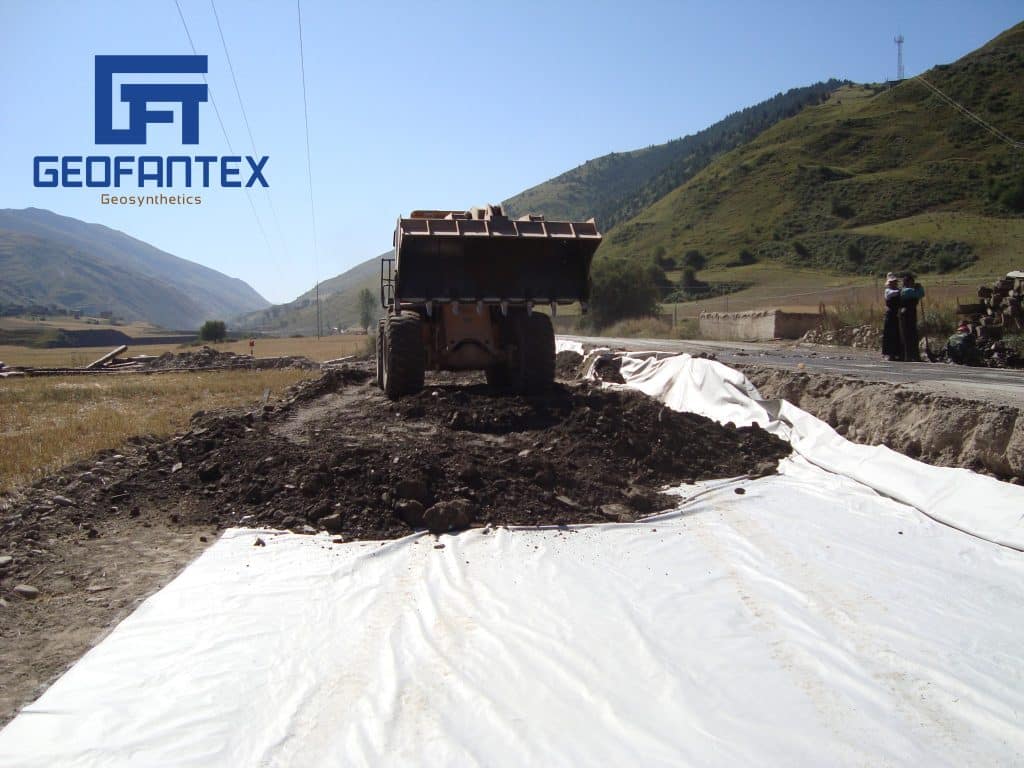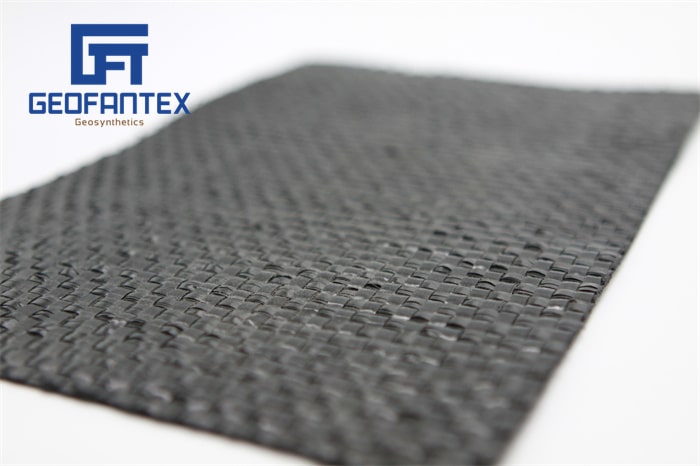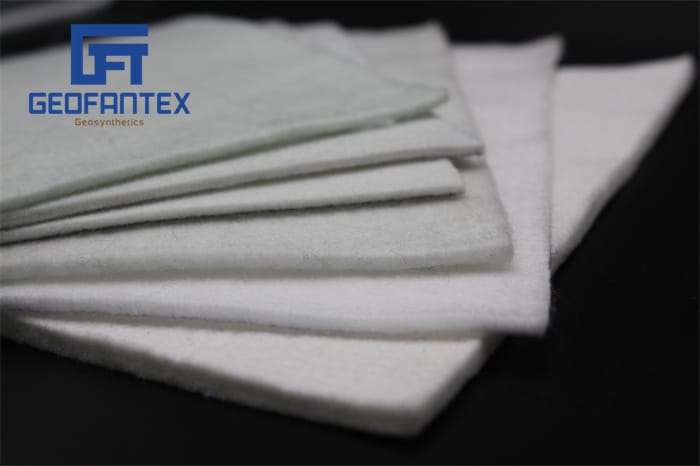Post Contents
- What Is Geotextiles?
- Types of Geotextiles
- Application of Geotextile
- Function of Geotextile
- Characteristics of Geotextiles
- Advantages of Geotextiles
- Disadvantages of Geotextiles
- FAQs:
What Is Geotextiles?
Geotextiles are synthetic and permeable materials used in civil construction systems for improved soil characteristics. Geotextiles make poor soils more suitable for construction, as they have the capability to separate, filter, reinforce, cover, and drain the soil.
What Is Geotextiles
Geotextiles are helpful in lots of infrastructure works such as roads, landfills, ports, drainage structures, and other civil engineering projects.

Types of Geotextiles
Geotextiles are made from polymers such as polypropylene and polyester. They are divided into three categories according to their manufacturing process:
- Woven fabric
- Nonwoven fabric
- Knitted fabric
1. Woven Fabric Geotextiles
Woven fabric geotextiles are the most common, and their manufacturing technology is similar to that of clothing fabrics. This type of geotextile is made from parallel threads or two sets of threads.

2. Nonwoven Fabric
Nonwoven geotextiles are made of continuous yarn fibers or short–staple fibers. They relate to thermal, chemical, or mechanical approaches or a combination of techniques.

3. Knitted Fabric
Knitted Geotextiles
Knitted geotextiles are made by interlocking a series of yarn rounds together. These geosynthetics are created by combining the weaving approach with other techniques such as weaving.
Read More: What Is Soil Stabilization | Soil Stabilization Methods | Types of Soil Stabilization

Application of Geotextile
The following are the major geotextiles applications,
Uses of Geotextile In Construction
The scope of geotextiles in the engineering field is indeed huge. The use of geo fabric is given under the heading Nature of Work.
Road Work
Geotextiles are commonly used in road construction. It strengthens the soil by adding tensile strength. It is used as a rapid water level in roadbeds, geo-textiles fabric need to preserve their permeability without losing their individual functions.
Railway Works
Woven or non–woven fabrics are used to separate the soil from the sub–soil where the ground is unstable, without impeding the rotation of the groundwater.
Covering the individual layers with fabric prevents the material from straying from the edge due to shocks and vibrations from moving trains.
Agriculture
It is used for sludge control. To enhance muddy paths and trails used by cattle or light traffic, non–woven fabrics are used and folded by overlaying to contain a mass of pipe or grit.
Drainage
The use of geotextiles for soil filtration and more or less single–sized granular materials to transport water is seen as a technically and commercially feasible alternative to conventional systems.
Geofabrics perform the filtering process in earth dams, roads and highways, reservoirs, retaining walls, deep drainage ditches, and drainage in agriculture.
River, Canals, and Coastal Works
Geotextiles cover river banks from erosion caused by currents or lapping. When used in convergence with natural or artificial encapsulation, they act as a filter.
Read More: Black Cotton Soil | Black Cotton Soil Properties | Types of Foundation In Black Cotton Soil
Function of Geotextile
Separation
- The separation porous geotextile layers are placed between the two different or dissimilar materials so that the functioning of two different materials can remain intact or can be improved.
- Separation is used in transportation applications for preventing the intermixing of two adjacent layers of soil.
- The geotextile layer is used as a separator for the fine sub-grade soil from the fine aggregate of the base course. Also, the geotextiles have preserved the strength of the aggregate and drainage.
- Geotextile separators are used for all types of roads, different types of foundations, and base levels of structure.
- Also, Geofabrics are preventing the premature failure of the structure, and separators prevent the pumping effect which is created by dynamic load and provide passage for water while retaining the soil particles.
Some areas were used for separation purposes,
- Between paved and unpaved roads.
- Used for an airfield.
- Between subgrade and stone base.
- Between landfills and stone course.
- Between sand drainage layers and geomembranes.
- Beneath Sidewalks slabs.
- Beneath Curb Areas.
- Beneath parking lots.
- Beneath sports and athletic fields
Filtration
- Filtration is the equilibrium textile layer to the soil, that allows the proper water flow with minimum loss of soil across the plane of geotextile.
- The material of filtration can be either nonwoven or woven type, which is permitted the water passage while retaining soil particles.
- Infiltration action, permeability, and porosity are the major properties of geotextile, and geotextile warping application is used for both vertical and horizontal drains. also, this warping application is used for the replacement of graded aggregate.
Reinforcement
- This is the synergistic improvement in the total system strength created by the introduction of a geotextile into the soil and developed primarily through the following three mechanisms,
- Lateral restraint through interfacial friction between geotextile and soil or aggregate.
- Membrane types of support of the wheel load.
- Potential bearing surface failure plane forcing to the development at the alternate higher shear strength surface.
- In the above method, the structural stability of the soil is greatly improved by the tensile strength of the geosynthetic material.
- This concept is similar to plain concrete with steel. Since concrete is weak in tension reinforcing steel is used for strengthening purposes.
- Geosynthetic material is functioning similarly to the reinforcing steel by providing strength that helps to hold the soil in that place.
- A geogrid or geotextiles are in provide reinforcement for allowing embankments and roads to be built over very weak soils and allowing steeper embankments to be built.
- This arrangement is similar to that of reinforced concrete with steel. Since concrete is weak in tension, reinforcing steel is used to strengthen it. Geosynthetic materials function in a similar manner as the reinforcing steel by providing strength that helps to hold the soil in place.
- The reinforcement is providing for geotextiles and geogrids, that is allow the embankment and roads to be built over weak soils and allow for the construction of the steeper embankment.
Sealing Function
- The nonwoven type geotextile is performing this function when impregnated with asphalt or polymeric mix rendering, it is relatively impermeable to both planes such as in-plane and cross-plane flow.
- The nonwoven geotextile membranes are placed on the existing surface of the pavement.
- The geotextile absorbs the asphalt to become a waterproofing membrane.
- That is minimizing the vertical flow of water into the pavement structure.
Read More: SBC of Soil | Safe Bearing Capacity of Soil | Minimum SBC of Soil for Construction
Characteristics of Geotextiles
The following geotextile characteristics are described,
Physical Properties of Geotextiles
- Specific Gravity
- Weight
- Thickness
- Density
Mechanical Properties of Geotextiles
- Tensile Strength
- Bursting Strength
- Tenacity
- Drapability
- Compatibility
- Flexibility
- Tearing Strength
- Frictional Resistance
- Porosity
Hydraulic properties of Geotextiles
- Porosity
- Permittivity
- Permeability
- Transitivity
- Turbidity or Soil retention
- Filtration Length
- Permittivity
Degradation Properties of Geotextiles
- Biodegradation
- Hydrolytic degradation
- Photodegradation
- Chemical Degradation
- Mechanical Degradation
- Another Degradation occurs due to attacks of termites, rodents, etc.
Endurance Properties
- Elongation
- Abrasion Resistance
- Clogging Length and Flow
Advantages of Geotextiles
- They are light in weight which makes them easy to handle and place.
- The transportation and labor cost is less in real terms.
- Knitted fabrics have high incision strength.
Disadvantages of Geotextiles
- Installation of geotextiles is critical and requires specialist contactors.
- These can delay seed germination due to low soil temperature.
- It has maximum flow rates.
- The base is not suitable for traffic areas.
FAQs:
What are the types of Geotextiles?
Geotextiles are made from polymers such as polypropylene and polyester. They are divided into three categories according to their manufacturing process: Woven fabric Nonwoven fabric Knitted fabric
What is the Application of Geotextile?
Uses of Geotextile in Construction Road Work Railway Works Agriculture Drainage River, Canals, and Coastal Works
What are the advantages of Geotextile?
- They are light in weight which makes them easy to handle and place.
- The transportation and labor cost is less in real terms.
- Knitted geotextiles have high incision strength.
what is geotextile fabric?
Geotextiles are synthetic and permeable materials used in civil construction systems for improved soil characteristics. Geotextiles make poor soils more suitable for construction, as they have the capability to separate, filter, reinforce, cover, and drain the soil.
You May Also Like:
- What Is Soil Stabilization | Soil Stabilization Methods | Types of Soil Stabilization
- Black Cotton Soil | Black Cotton Soil Properties | Types of Foundation In Black Cotton Soil
- 14 Types of Compaction Equipment used in Construction | Compacting Machines | Types of Compactors | Soil Compaction Equipment
- SPT Test | Standard Penetration Test | Soil Penetration Test | Standard Penetration Test Procedure | SPT Test Report
- Floating Slab | Float Slab Foundation | Floating Concrete Slabs
- SBC of Soil | Safe Bearing Capacity of Soil | Minimum SBC of Soil for Construction
Related
What Is Soil Stabilization | Soil Stabilization Methods | Types of Soil Stabilization
What Is Soil Stabilization? Soil stabilization is a method of improving soil properties by adding and mixing other materials to it. Soil stabilization is a method of enhancing the shear strength parameters of soil and thus increasing the bearing capacity of the soil. It is generally required when the soil…
17/09/2020
In “Miscellaneous”
A Guide To Green Roof Construction and Functions
Modern structures strive to follow the standards for sustainable building. It is an exciting prospect to many designers as they come up with many out-of-this-world ideas. One of the many concepts that truly amazes a lot of people is a green roof. This type of roof is slowly getting more…
15/07/2021
In “House Construction Tips”
Floating Slab | Float Slab Foundation | Floating Concrete Slabs
What Is a Floating Slab? Floating Slabs are concrete slabs that are laid on the ground without any anchoring, such that it simply sits and floats on them. The floating slab, as the name suggests, looks like a plate, which is only placed on top of the water, with no…
17/07/2021
In “Foundation”
Share This Post
